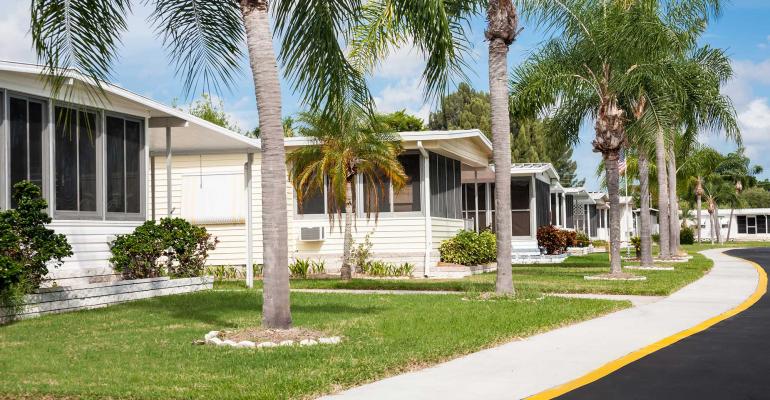There has been stable occupancy and rental collections in 2020 despite the pandemic. As a result, some investors are now betting big on manufactured housing communities.
In the second quarter of 2020, investment sales of manufactured housing communities totaled $821 million, a 12 percent increase compared to the fourth quarter of 2019 and a 23 percent increase over the first quarter of 2020, reports commercial real estate services firm JLL. At the same time, valuations in the sector have continued to increase and cap rates have been compressing. Price per pad in the second quarter averaged $50,792, up 6.6 percent from the first quarter of 2020 and 26 percent year-over-year. During the same time period, prices on multifamily assets have declined by 5.3 percent from the first quarter of 2020 and 0.86 percent year-over-year, according to a JLL report on manufactured home communities. Cap rates on manufactured housing communities averaged 5.84 percent nationally, down seven basis points year-over-year.
“The manufactured housing community sector has overall continued to drive year-over-year occupancy gains, often through investments into new and used inventory to support manufactured home sales and rental programs,” says Scott Belsky, senior vice president and JLL valuation advisory national practice lead for manufactured housing. “Additionally, the stability and growth of homesite rents have generated positive net operating growth even through the pandemic, which has allowed values to remain stable or even rise in some areas due to continued investor interest driven by the sector’s lack of volatility and even rent growth prospects.”
Stabilized occupancy in the sector during the second quarter averaged 93.5 percent, close to an all-time high, JLL reports. The upward trend was particularly noticeable in Western U.S., which saw average occupancy reach 94.7 percent. The sector also continued to post rent growth during the quarter, at an average of 1.5 percent, though that was below the 1.9 percent compounded annual growth rate achieved over the past 10 years.
Among the REITs specializing in manufactured and mobile home communities, Equity Lifestyle Properties, reported average occupancy of 95.2 percent for the second quarter (ended June 30), up 10 basis points from the first quarter of 2020 and the second quarter of 2019, according to its most recent earnings report. The REIT reported that the base rental income for its portfolio increased by $6.3 million, or 4.6 percent, compared to 2019. Sun Communities, another REIT that specializes in the sector, reported average occupancy of 96.5 percent during the second quarter.
“Manufactured housing has generally maintained consistent occupancy levels and rental rates since the beginning of 2020,” says Norm Sangalang, senior vice president of manufactured housing at real estate services firm CBRE. “Manufactured housing communities historically experience a reduced fluctuation in occupancy and rental rates compared to other housing types. In the current market conditions, a portion of the lower fluctuation can be attributed to manufactured housing communities being typically located outside of the downtown centers and more likely to be in a surrounding submarket.”
As the supply of manufactured homes declines as a result of zoning restrictions and is combined with U.S. consumers’ search for housing affordability, net demand for manufactured homes is only expected to increase. There is also strong demand for manufactured homes from the baby boomers that is expected to last for the long term, with demand outpacing supply, according to the Equity Lifestyle Properties’ earnings report.
“Demand is met with a limited supply due to a nearly static number of manufactured housing communities,” says Sangalang. “While other forms of housing see new development or redevelopment from other property uses occurring, perhaps even at a slower pace in some markets, manufactured housing communities has only experienced a small fraction of new supply introduced over the past 20 years. There are many factors with the imbalance of supply and demand being the underlining driving factor.”
Investor interest in acquiring manufactured home communities will continue and most likely grow over the next year because of the consistency in their operations and ability to finance them, says Sangalang. Private capital totaled 70 percent of investment into the sector year-to-date, while institutional investment totaled 28 percent of investment, the highest percentage of institutional capital investment ever recorded, according to JLL data.





